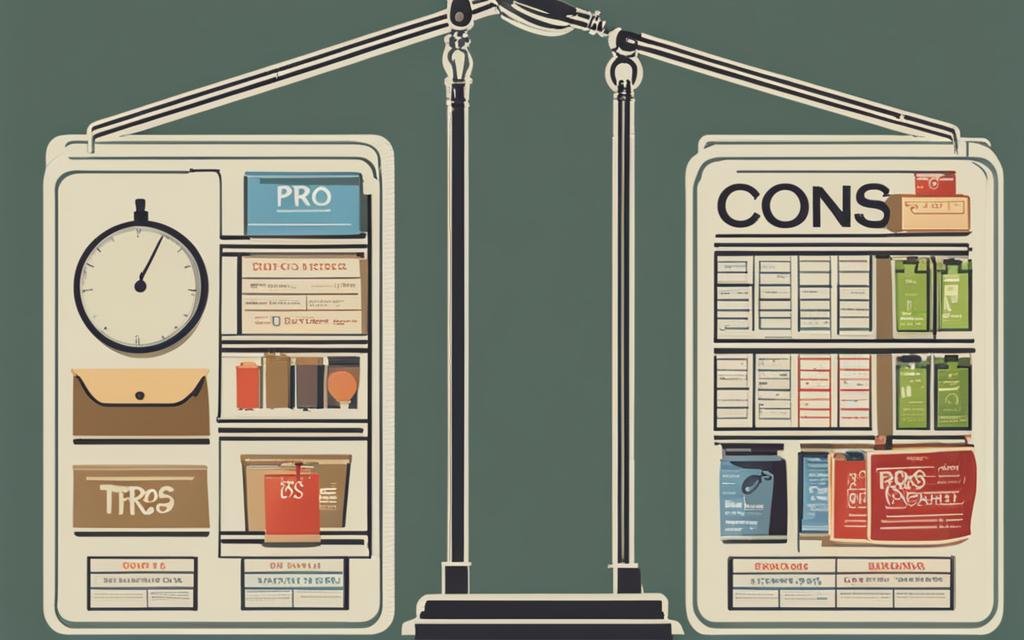Are you tired of paying full price for items in physical stores? Well, it’s time to master the art of negotiation and start securing the best deals for yourself. Negotiation is a skill that can help you save money, get more value for your dollar, and walk away feeling like a savvy shopper.
When it comes to negotiating in physical stores, understanding the psychology behind it is essential. Factors such as the anchoring effect, framing, and the perception of luxury versus necessity can significantly impact the outcome of a negotiation. By leveraging these psychological principles, you can increase your chances of getting a better deal.
Building relationships and trust is another crucial aspect of successful negotiations. By using reciprocity and demonstrating trustworthiness, you can establish a rapport with the seller and increase your chances of a favorable outcome. And don’t underestimate the power of silence in negotiations. Knowing when to pause and let the silence work in your favor can be a game-changer.
Key Takeaways:
- Understanding the psychology behind negotiation can give you an advantage in getting better deals.
- Building relationships and trust with sellers is crucial for successful negotiations.
- Silence can be a powerful tool in negotiations, knowing when to use it is key.
- By mastering the art of negotiation, you can become a savvy shopper and secure the best deals in physical stores.
Understanding the Psychology of Price Negotiation
In the art of negotiation, understanding the psychology of price is crucial for achieving successful outcomes. When engaging in price negotiation, it’s important to recognize how people perceive the value of a product or service. This understanding can help you navigate the negotiation process more effectively and increase your chances of securing the best deals in physical stores.
One psychological factor that influences price negotiation is the anchoring effect. This refers to the tendency for individuals to rely heavily on the first piece of information presented to them when making decisions. In a negotiation, this could mean that the initial price offered by the seller sets the baseline for the negotiation. Being aware of this effect allows you to strategically anchor the negotiation in your favor.
Another important aspect of the psychology of price negotiation is framing. How a price is presented can significantly impact the perceived value of the product. For example, framing the price as a discount or a limited-time offer can make it more appealing to the buyer. Understanding how to frame your offers and counteroffers can give you an advantage in the negotiation process.

Perception of luxury vs. necessity
The perception of luxury versus necessity also plays a role in price negotiation. Buyers are more likely to spend more on products they perceive as luxury items rather than essential goods. By understanding this distinction, you can position your offer as a luxury item and emphasize the unique value it brings. This can help justify a higher price and increase your chances of reaching a favorable agreement.
To maximize your negotiation success, it’s also important to consider the emotional aspect of price negotiation. Buyers’ emotions, such as emotional attachment to a product or fear of missing out, can influence their willingness to pay. By leveraging emotional triggers and creating a sense of urgency, you can increase the perceived value of your offer and improve your negotiation position.
Building trust and reciprocity are essential elements of successful price negotiation. Demonstrating trustworthiness and building rapport with the other party can create a positive negotiation environment. Additionally, using silence as a tactic can create discomfort and prompt concessions from the other party. Knowing when to utilize silence and other negotiation strategies will further enhance your negotiation skills and improve your chances of achieving the best deals in physical stores.
Setting Your Negotiation Goals and Limits
When it comes to negotiation, having clear goals and limits is essential for success. By setting your negotiation objectives, you can focus your efforts and ensure that you’re working towards achieving the outcomes you desire. Start by defining what you want to achieve from the negotiation process. Are you looking for a specific price reduction or certain added benefits? Clearly outlining your goals will help guide your strategy.
It’s also important to assess alternatives and research market standards. Understanding the alternatives available to both parties gives you leverage during negotiations. Researching market standards allows you to better gauge what is reasonable and realistic in terms of your negotiation goals. By having this knowledge, you can present your case with confidence and increase the chances of reaching a favorable outcome.
In addition, consider the perspective of the other party involved in the negotiation. Understanding their needs, motivations, and limitations can help you tailor your approach and find common ground. This empathy and consideration for their point of view can foster a cooperative atmosphere and build rapport, which can be advantageous during negotiations.
Lastly, determine your walk-away point, also known as your negotiation limit. Knowing when to walk away is as important as knowing when to push for more. Establishing your limits ensures that you protect your interests and don’t settle for less than what you’re willing to accept. By setting clear goals and limits, you can approach negotiations with confidence and increase your chances of achieving a successful outcome.
The Art of Negotiation: Tips for Getting the Best Deals in Physical Stores
Crafting Persuasive Arguments and Counterarguments
When engaging in negotiations, one of the most critical skills you can develop is the art of crafting persuasive arguments and counterarguments. Effective communication tactics can help you navigate the negotiation process and increase your chances of achieving favorable outcomes. Here are some key strategies to consider:
- Understand the other party’s perspective: To present your arguments persuasively, it’s crucial to understand the motivations and concerns of the other party. By identifying their needs and desires, you can tailor your arguments to resonate with them.
- Use logic and evidence: Supporting your arguments with logical reasoning and credible evidence can make them more persuasive. By providing facts, statistics, or examples, you can strengthen your position and increase your chances of influencing the other party.
- Address objections: Anticipate potential objections or concerns that the other party may raise and be prepared to counter them. By understanding their potential objections, you can develop persuasive responses that address their concerns and alleviate any doubts or hesitations they may have.
- Practice active listening and empathy: Demonstrating active listening skills and empathy can help build trust and rapport with the other party. By showing that you understand their perspective and genuinely care about their needs, you can create a more collaborative negotiation environment.
By employing these strategies, you can enhance your ability to craft persuasive arguments and counterarguments during negotiations, increasing your chances of achieving successful outcomes.

Leveraging Timing and Context to Your Advantage
When it comes to negotiation, timing and context can make a significant difference in the outcome. By understanding how to leverage these factors to your advantage, you can increase your chances of securing the best possible deal. Here are some key strategies to consider:
1. Identify opportune moments
Timing plays a crucial role in negotiation. Keep an eye out for situations where sellers may be more willing to make concessions. For example, during a slow sales period or when a new model of a product is about to be released, sellers may be more open to negotiation. By recognizing these opportune moments, you can negotiate from a position of strength.
2. Consider the context
Contextual factors can also impact negotiations. Take into account the wider market conditions, competitor offerings, and any external factors that may influence the seller’s position. Understanding the broader context allows you to tailor your negotiation approach accordingly.
3. Apply strategic pressure
Creating a sense of urgency or pressure can work to your advantage in negotiations. For example, if you have alternative options or a tight deadline, you can use that leverage to push for better terms or discounts. However, it’s important to strike the right balance and avoid excessive pressure tactics that may harm the relationship.
By leveraging timing and context in your negotiations, you can position yourself for success. Remember to be flexible, adaptable, and sensitive to the other party’s needs and motivations. Negotiation is a delicate dance, and mastering these elements can give you a significant advantage.

Negotiation Tactics and Strategies
When it comes to negotiation, having a variety of tactics and strategies in your arsenal can greatly enhance your chances of success. Here are some effective approaches that you can use to secure the best deals in physical stores:
1. Make a compelling case:
Presenting a strong argument supported by evidence can significantly influence the other party’s decision. Highlight the unique features or benefits of the product or service you’re negotiating for, and demonstrate its value. Show how it meets their needs or solves their problems better than alternative options.
2. Find flaws:
Do your research and identify any weaknesses or shortcomings in the product or service. Pointing out these flaws can give you leverage in the negotiation process. However, be respectful and tactful when raising concerns, as you still want to maintain a positive rapport with the seller.
3. Seek discounts for cash:
If you’re able to pay in cash, use it as a bargaining chip to negotiate a better price. Sellers often prefer cash payments due to lower processing fees and faster transactions. Offer to pay upfront or in full immediately to incentivize the seller to offer a discounted price.
4. Show expertise:
Demonstrate your knowledge and expertise in the product or market to establish credibility. This can be done by asking informed questions, quoting industry trends or research findings, or sharing your own experiences. By positioning yourself as an informed buyer, the seller may be more willing to accommodate your requests.
By employing these negotiation tactics and strategies, you can increase your chances of getting the best possible deal in physical stores. Remember to always approach negotiations with confidence, preparation, and a clear understanding of your goals and limits.

Conclusion
In conclusion, mastering the art of negotiation is crucial for securing the best deals in physical stores. By understanding the psychology of price, setting clear goals and limits, crafting persuasive arguments, leveraging timing and context, and employing effective negotiation tactics and strategies, you can become a savvy shopper. Negotiation is a complex process that requires practice and knowledge, but with dedication, anyone can improve their negotiation skills and achieve successful outcomes.
Remember, negotiation is not just about getting the lowest price; it’s about finding a mutually beneficial solution. Building trust, listening actively, and empathizing with the other party are equally important. By adopting a cooperative mindset and focusing on win-win outcomes, you can strengthen relationships and create long-lasting partnerships.
So, the next time you step into a physical store, approach your negotiations with confidence and a structured approach. Be prepared, stay calm, and leverage your understanding of the psychology of price and effective negotiation techniques. With these skills in your arsenal, you can navigate the world of physical store negotiations with ease and walk away with the best possible deals.
FAQ
How does the psychology of perception influence price negotiation?
The psychology of perception, including the anchoring effect, framing, and the perception of luxury vs. necessity, can significantly impact price negotiation outcomes.
What role do emotions play in price negotiation?
Emotions such as leveraging emotional attachment and creating a fear of loss can influence buyers’ willingness to pay and affect negotiation outcomes.
Why is building relationships and trust crucial in negotiations?
Building relationships and trust through strategies like reciprocity and demonstrating trustworthiness can lead to more successful negotiation outcomes.
How can silence be used as a tool in negotiation?
Silence can be a powerful tactic in negotiation, creating discomfort and prompting concessions from the other party.
What are some essential factors to consider in effective negotiation?
Setting clear goals and limits, understanding the other party’s perspective, and being prepared and focused are essential factors in effective negotiation.
How can effective communication skills improve negotiation outcomes?
Crafting persuasive arguments and counterarguments, addressing objections, and actively listening with empathy can help build trust and achieve successful negotiation outcomes.
How does timing and context influence negotiation outcomes?
Understanding when to negotiate and considering external factors such as anxious sellers or favorable market conditions can give you an advantage in negotiation.
What are some negotiation tactics and strategies?
Tactics and strategies include making a compelling case, finding flaws, seeking discounts for cash, showing expertise, asking open-ended questions, and being discreet about your negotiation.
How can I improve my negotiation skills?
Practice and knowledge are key to improving negotiation skills. By mastering the art of negotiation, individuals can secure the best deals in physical stores and become savvy shoppers.

